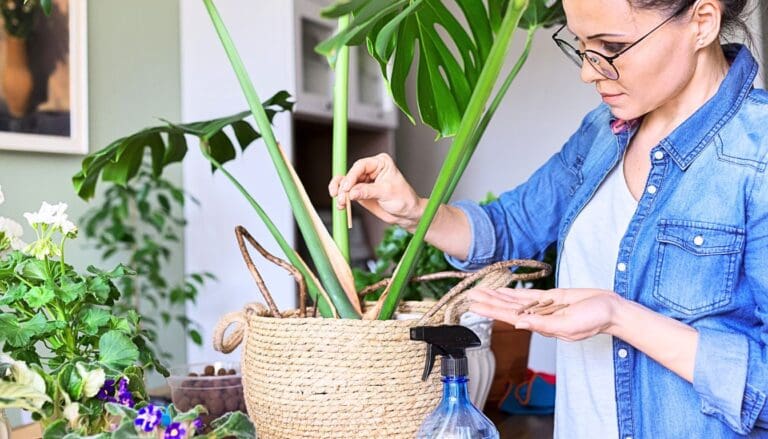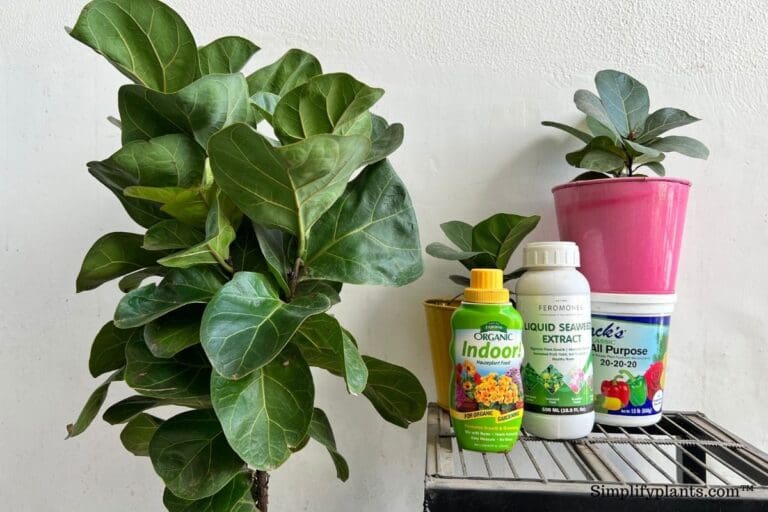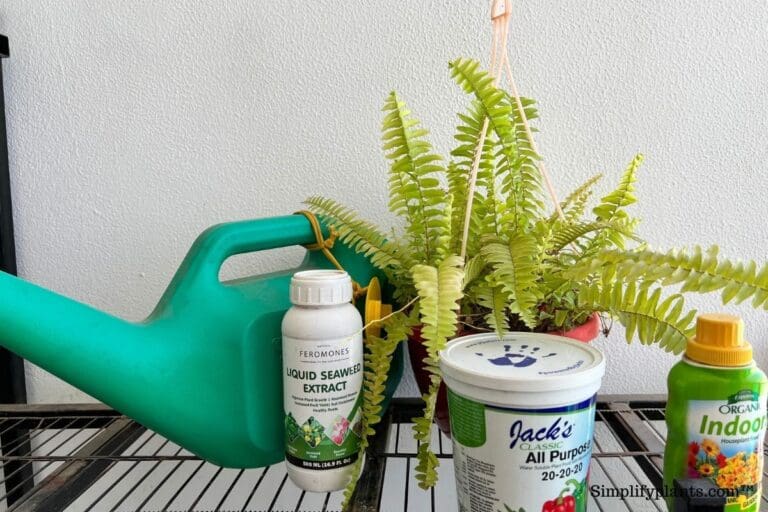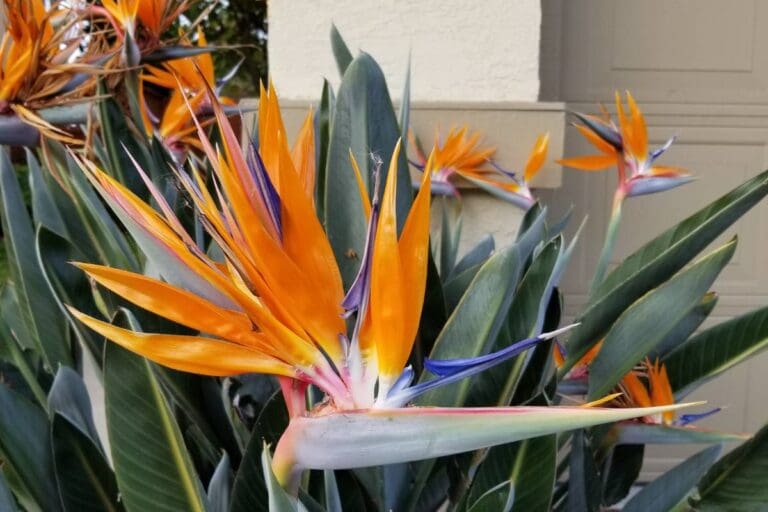Root Rot In Spider Plant: Signs, Causes & How-To Save
Spider plants are hardy plants that require a little care to grow. But when the plant owner doesn’t look after their plant at all or ignore their needs, then the spider plant may suffer from root rot. Root rot can be life-threatening for your spider plant. But what causes root rot, and what can we do to overcome it?
Overwatering is the primary cause of root rot as it suffocates the roots and constricts the oxygen flow resulting in damaged roots. Yellowing of leaves and mushy roots are common signs of root rot. Repotting the plant, providing appropriate lighting, and letting the soil dry out can help you save your spider plant.
I know root rot can be a big concern for some plant owners. However, today we will understand the root cause of root rot in spider plant and how we can fix the same.
We will also discuss how to prevent root rot and some tips for taking care of your spider plant and keeping them healthy.
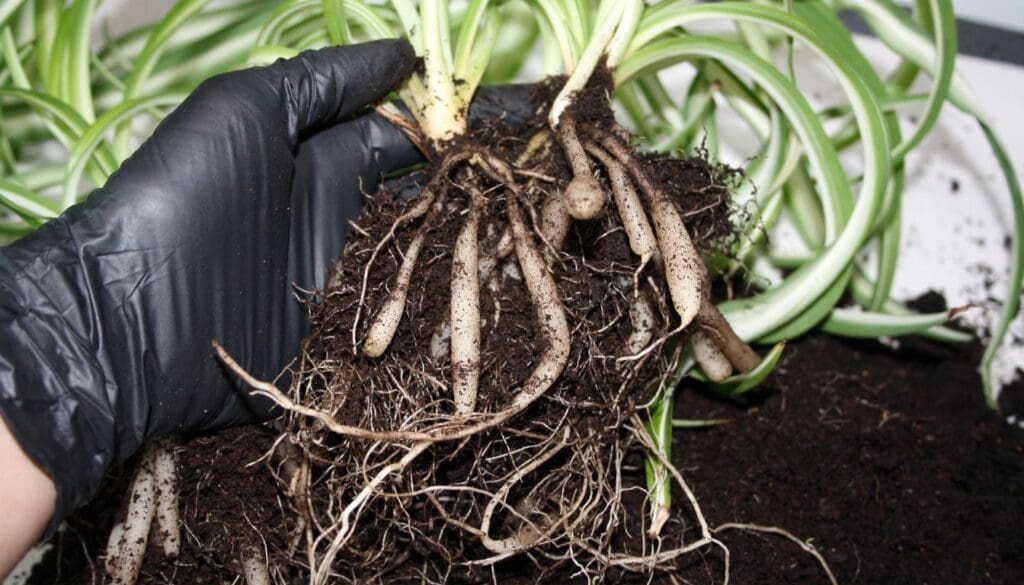
Please note: Simplify Plants is reader-supported. Some links in the post are affiliate links and I get a commission from purchases made through links in the post.
Signs of root rot in spider plant
Root rot is usually the case after the damage has been done to your loving plant. They spread under the soil, and you might know only when the situation is complicated and out of control.
If you know the clues your plant starts giving after getting affected, you might cure the issue when the situation is in control.
Since the symptoms resemble other plant problems, we need to know what exactly could indicate root rot. Following are the signs:
Brown and mushy roots
The plant will suffer the most when the plant roots are in trouble. When suffering from root rot, the problem begins at the plant’s roots. They become weak, mushy, and brown when affected due to root rot.
The main issue is not that they are affected but that you will hardly be able to tell that your plant is suffering this much from within.
If you feel the plant is not behaving right and cannot see any visible clues from outside, dig deeper and pull out the plant to check the roots’ condition.
Also, don’t panic if the roots break down while pulling the plant out; as we told earlier, the roots have become weak and vulnerable.
Foul odor from roots
One of the signs at the initial stages of root rot is a foul odor from the roots. If you don’t know about it, it’s okay because all you need to check is whether there is an odd smell coming out from the soil and roots.
It is the roots that are affected and smelling like that because they have got slimy, mushy, brown, and all smelly.
The good news is if you identify this stink before the foliage gets affected, then you might save your plant from more damage.
Stagnant growth
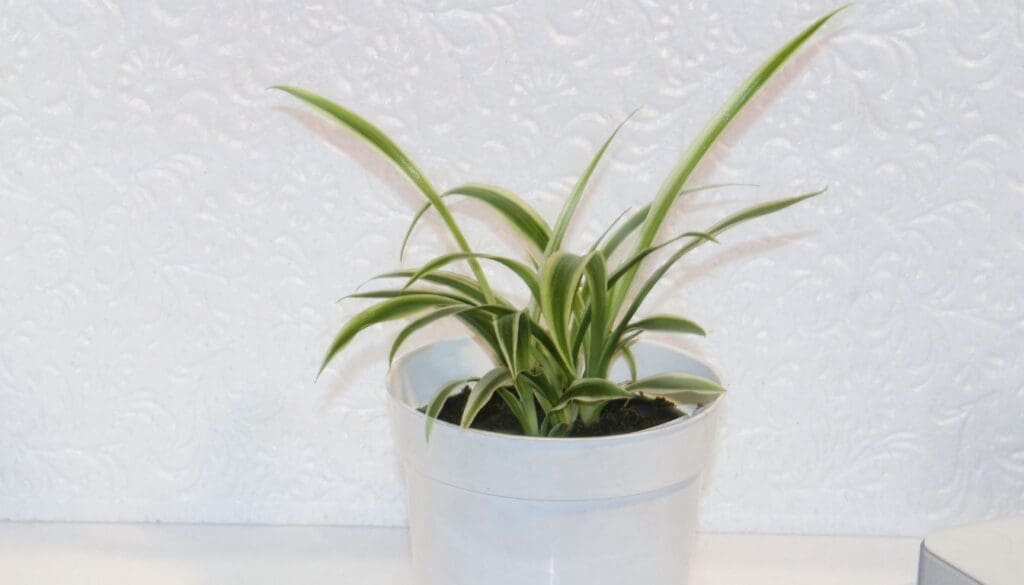
The growth of your spider plant may suffer due to root rot. That is heartbreaking but true because the roots are affected. When the roots and soil are unhealthy, it will affect the entire plant.
The leaves might not show the roots and soil’s health anytime soon, but if you don’t see any new growth on your plant, then root decay could be the reason.
Since the symptoms are not so visible, you may not know initially. But as soon as you realize that there is no new growth for a long time and all other conditions are on point, then check the roots.
Also read: Why is my spider plant not growing?
Wilted leaves
Wilted leaves of spider plants indicate many issues such as under watering, pests infestation, or root rot. These basically indicate a lack of nutrients or roots that cannot absorb the required nutrients.
The leaves will get affected due to internal issues such as root rot and will lead to more issues when the roots are unhealthy for long.
Black spots
Black spots on leaves often indicate root decay on your spider plant. It happens mostly due to overwatering or diseases.
Pathogens grow vigorously and take over your spider plant’s roots for a long time, which may lead to even death of the plant.
What causes root rot in spider plants?
Various factors can cause root rot in spider plants. These include overwatering, improper drainage, temperature fluctuations, etc.
Let us get into the details of each of the problems and how you can control it in time.
Overwatering
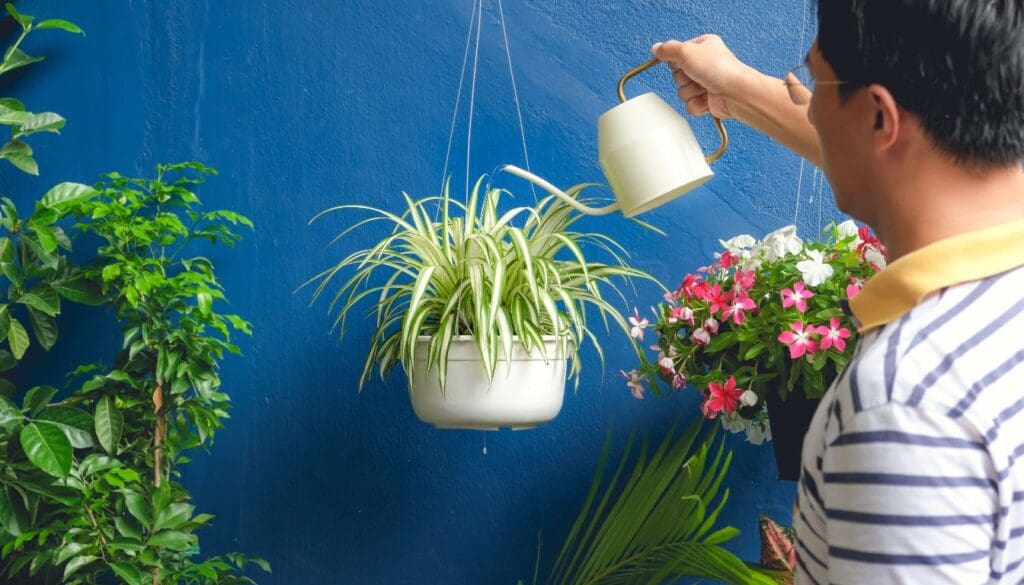
Overwatering your spider plant is like inviting your plant’s death. We don’t mean that just by overwatering your spider plant once, your plant will die. We mean that overwatering continuously will lead to ruining the plant’s health.
When you overwater your spider plant, there are few problems that you might notice initially on your leaves, such as:
The excess water staying in the soil is suffocating the soil and roots, making it difficult for the roots to breathe. The flow and uptake of water and nutrients will suffer, affecting the plant’s health.
This condition will make the roots weak and vulnerable. The roots will decay, become susceptible to diseases, and it will be tough to retain them to life.
Waterlogged soil and roots become dysfunctional as they cannot function and regulate the flow of air, water, and nutrients in and to the other parts of the plant.
Following a particular watering routine is one reason why many planters pour their love into their plants without checking with them.
Also read: How much water do spider plant need?
Poorly drained soil
Soil is an integral part of any plant and primarily affects the plant’s health. You need the soil mix for your spider plant to be aerated and light.
A well-aerated soil mix will allow easy flow of water, air, and nutrients. It will also absorb water quickly and allow easy airflow.
The heavy soil mix will take a lot of time to dry out, not allow oxygen to pass easily, and also will stay wet from within even if the top seems dry.
At times, the plant owner is watering right but still faces root rot issues, and this happens when the soil mix is heavy, and the excess water cannot pass out completely.
Also read: What kind of soil is good for spider plant?
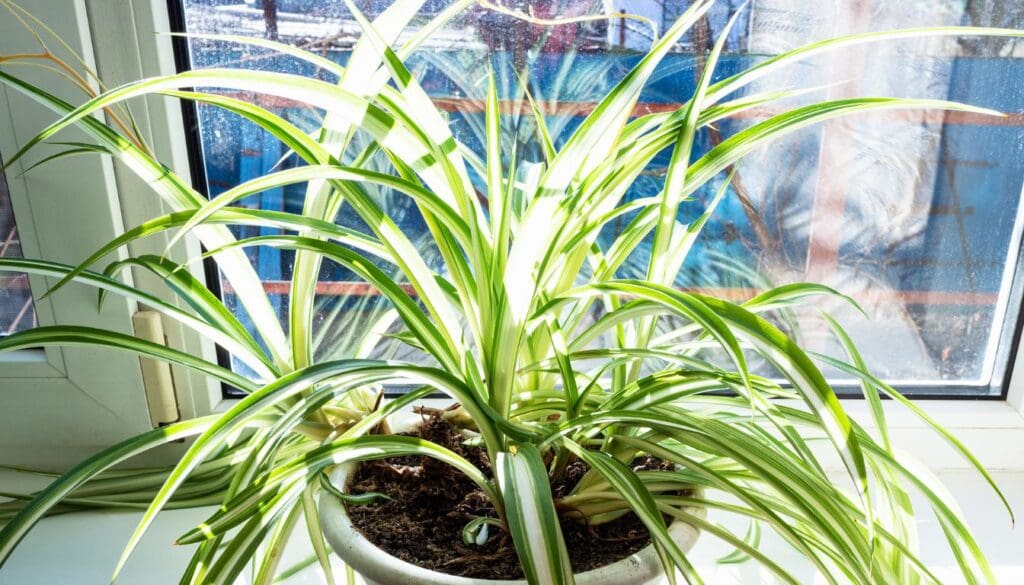
Inappropriate temperature
When the temperature level is inappropriate for spider plants, then the plant may suffer. The inappropriate temperature for spider plants would be anything below 50 degrees Fahrenheit.
When the temperature stays below 50 degrees Fahrenheit for a long time, the spider plant will have a tough time. The water in the soil will not dry out fast, and the spider plant will not get enough light to generate energy. That makes a perfect condition for root rot.
Too much temperature level is also not appreciated by the spider plant though it will not lead to root rot, but other issues like leaf burn and droopy leaves are likely.
Also read: Can spider plant be kept outside?
Poor drainage system
Due to cosmetic reasons, plant owners often use pots with no drainage holes. These pots are fine if you know how much water is required for the plant.
If you overwater them, the excess water will take up space completely, making it harder for the oxygen to stay and to flow.
Even if the drainage holes are there in the pot, sometimes the pebbles or roots may block the holes, making it hard for the water to drench completely, and that will gradually will lead to soggy soil.
The roots will become weak and can lead to root decay, fungal diseases, etc.
Over-fertilization
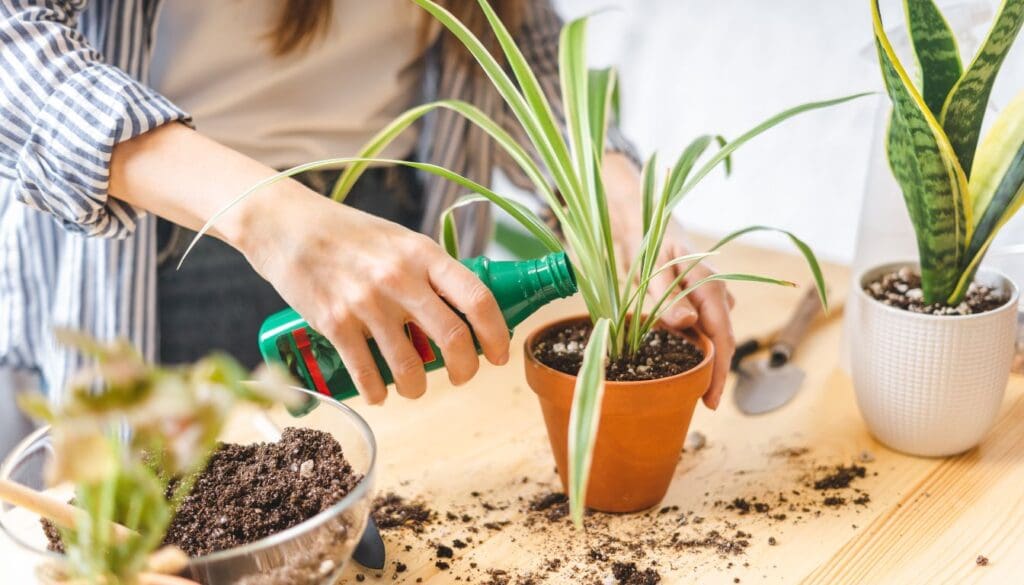
Overfertilizing the spider plant is always a big NO because they are light feeders. If you are one of those heavy feeders who feel feeding extra will result in faster and better growth.
That is not the case because excess fertilizing of your spider plant will lead to salt buildups in the soil, which will affect the roots.
The roots and soil functioning are likely to suffer. The roots will become weak and will create proper conditions for root decay.
Thus, make sure you monitor the dosage of fertilizer you use on your spider plant.
Also read: Do spider plant need fertilizer? How much?
Pythium root rot
Pythium root rot is usually due to overwatering or when the soil remains wet for several days.
The pathogens in the roots produce spores that germinate and infect plants. Overwatering will promote their products and spread quickly.
Contaminated soil also affects the roots. The dormant pathogens present in the soil and roots take over and lead to Pythium root rot.
Phytophthora root rot
Phytophthora roots rot affects the wet and poorly drained soil. They transmit from plant to plant and spread very quickly once inside the root ball.
Phytophthora produces pathogens that require moisture to thrive and spread. It starts with the roots, which usually plant owners don’t identify, and it keeps infecting the plant from within.
There could be signs that indicate Phytophthora root rot:
- No new leaf growth
- Interveinal chlorosis
- Wilting and discoloring
- Diebacks of shoots and leaves
Rhizoctonia root rot
Rhizoctonia root rot advances in moist conditions or due to contaminated soil. The contaminated cutting tools can also lead to Rhizoctonia root rot.
Even hot temperatures support the rot and become a problem during spring and summer. It affects the cuttings and young plants commonly.
This root rot situation restricts water and nutrients move into the plant, causing a wilting and nutrient deficiency.
Low lighting

Light is critical for any plant to grow and carry out necessary functions. The plants need proper light to break down nutrients into energy, dry out the wet soil, and other essential functions.
Spider plants need indirect light to thrive, and if you are not fulfilling their light needs and watering them without proper examination, then the chances of root rot increases.
If there is any chance you feel the roots are decaying, you must check on the light and water your plant is receiving.
Since the plant is not receiving enough light and you are not watering them properly, the soil will saturate and give a perfect environment for the pathogens to advance and result in root rot.
Also read: How much light do spider plant need?
Oversized pot

Every plant owners should not use oversized pots. They look fascinating but will create more problems for your plant than good.
Especially if you are a beginner, you should go for small or medium-sized pots. The reason being you might never analyze the water need of the plant. You may feel the soil is dry from the top, but that may not be the case from within.
Wet soil might suffocate the roots as the soil have bad airflow. The roots have all the conditions that lead to root rot, and the fungi need to grow and take over.
Also read: What happens when you pot a plant in too big of a pot?
Pot type
Pot type though not considered too essential but matters for providing a better environment to the plant. The spider plant growth and other needs get facilitated if the potting material is right.
If you consider plastic, glazed pot materials, then the chances are that the soil will remain wet for a long time and less airflow is facilitated, there are more chances of fungi attack.
The spider plant will stay happier in porous pots such as terracotta, ceramic because they allow easy water and airflow. They will prevent soil sogginess and reduce the chances of fungi attack and root rot.
Poor ventilation
Adequate ventilation is essential for any plant because it allows the plant to dry and have good health.
When there is poor ventilation around the plant, the plant may suffer from suffocation, moistness in the soil and also promote fungi growth.
Other causes of root rot on your spider plant
Spider plant may get affected with root rot due to some other reasons too, such as:
- Contaminated tools
- Newly bought plants already contaminated
- Garden soil or contaminated soil
- Stressed or vulnerable plants
How do you get rid of root rot on spider plants?
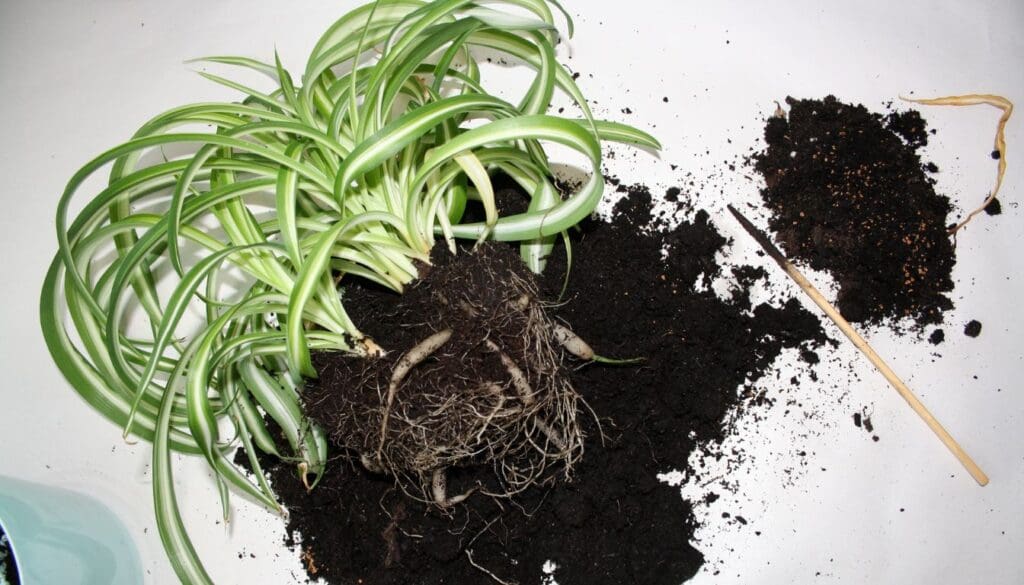
Fixing root is very crucial and should not be delayed.
Repotting is necessary in case of root rot to lessen its effect rapidly. If the condition is very severe, then the chances are that the plant may die.
We need to be gentle while carrying out the repotting process as it stresses your plant in an already stressed condition.
What you need for the process:
- Scissors
- Fresh potting soil
- New pot
- Bleach
- Fungicide
Steps:
- The first step is to pull the plant out of the plant very gently, get rid of the soil around the root ball, and dispose of it.
- Wash the plant thoroughly and remove dirt from the plant, prune decayed leaves, roots, so it doesn’t spread anymore.
- Now soak the roots in a bleach and water solution for a few hours to kill bacteria and fungi in the roots.
- You can optionally keep the plant in the air for one whole day or for a few hours to let the roots breathe and kill the remaining bacteria.
- Use a bleach solution to clean the pot you want to plant your spider plant in.
- To avoid wet soil in the future, line some pebbles in the bottom of the pot and make sure it has drainage holes.
- Repot your spider plant in a sterilized soil mix and make sure the soil mix is well-draining.
- For mild root rot conditions, stop watering till the soil gets completely dry. Only watering right will help to get rid of the mild rot.
- Avoid any fertilizer till the wet soil is dried and the plant gets back in a healthy condition.
How do I protect my spider plant from root rot?
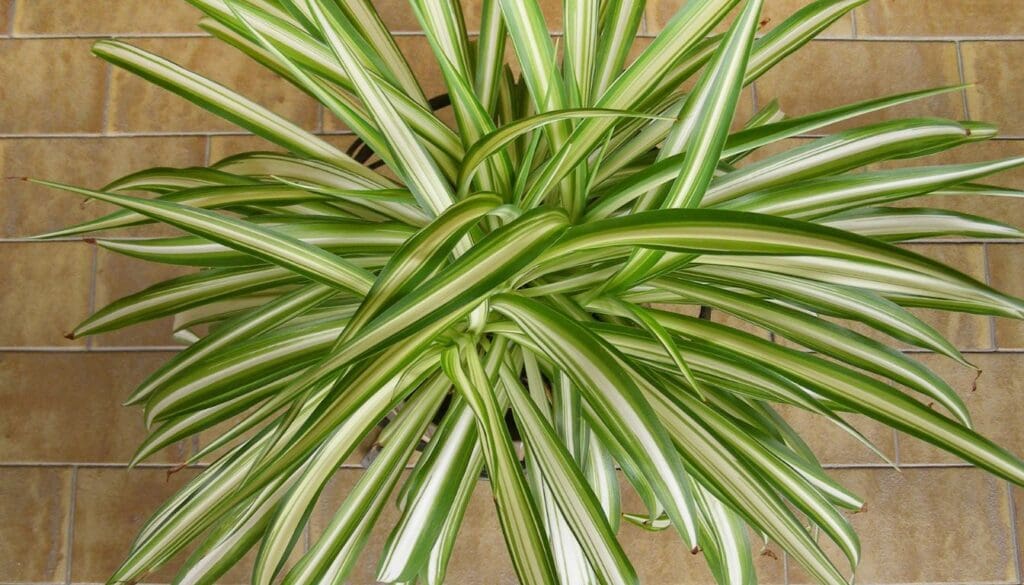
Prevention is always better than cure. In order to prevent root rot in your spider plant, you must follow and change your care routines or, let’s say, the way you care for your plant needs to be changed or monitored.
Avoiding few things like overwatering, over-fertilization, low-temperature levels, low humidity levels, pots with poor drainage, poorly draining soil mix, infected cuttings, plastic pots, and using contaminated soil can help you prevent root rot.
You can also save your plant from many common problems your plant faces, such as yellowing leaves, browning, wilting and curling, etc.
With regular inspection and avoiding extremities we mentioned above, you can keep your plant happy and address any issue in its initial stages only.
Also read: How to save a dying spider plant?
Tips to keep your spider plant thriving
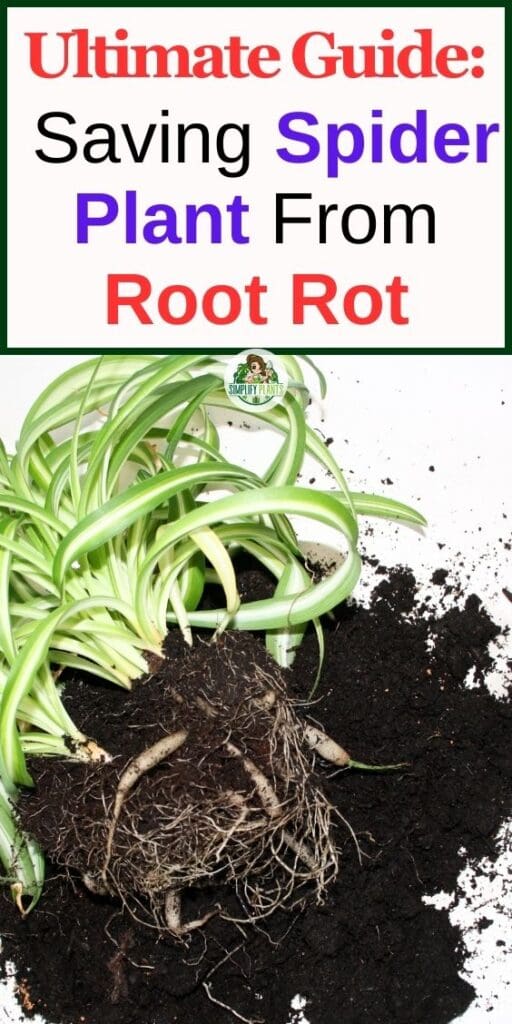
We have straightforward tips for keeping your spider plants healthy. These are:
- You need to take care of your spider plant’s water and light needs, which is a basic need for any plant. Your spider plant asks for water as the soil dries out and does not like to stay wet.
- Your spider plant needs indirect light all day long for consistent growth and to carry out other functions easily.
- While you use cuttings, make sure they are not contaminated, and you should sterilize the soil mix before you plan any newly bought plant.
- You should not place the plant near heating systems such as radiators, furnaces, or outdoors during too hot weather.
- Keep the newly bought plant isolated for a few days to ensure it is not contaminated.
Source: Common insect pests and diseases, College of agricultural studies, Spider Plants Introduction, University of Vermont, Spider plant care, National science foundation.
Recommended Garden Supplies
| Product Image | Our Recommended Gardening Supplies | Check Offers! |
|---|---|---|
Top Top
Top
Top
Top
Top
Top
Top
Top | rePotme Houseplant and Tropical Classic Potting Soil Mix | Check Offer On Amazon |
 Top
Top
Top
Top
Top
Top
Top
Top | Espoma Organic Indoor Plant Food | Check Offer On Amazon |
 Top
Top
Top
Top
Top
Top
Top
Top | GooingTop LED Grow Light 6000K Full Spectrum Clip Plant Growing Lamp | Check Offer On Amazon |
 Top
Top
Top
Top
Top
Top
Top
Top | Soil Moisture Meter | Check Offer On Amazon |
 Top
Top
Top
Top
Top
Top
Top
Top | Govee Hygrometer Thermometer, Bluetooth Enabled! | Check Offer On Amazon |
 Top
Top | LEVOIT Humidifiers for Large Room(Best For Plants) | Check Offer On Amazon |
 Top
Top
Top
Top
Top
Top
Top
Top | Upgraded DIY Automatic Drip Irrigation Kit, 15 Potted Houseplants Support | Check Offer On Amazon |
 Top
Top
Top
Top
Top
Top
Top
Top | Stainless Steel Heavy Duty Gardening Tool Set | Check Offer On Amazon |
 Top
Top
Top
Top
Top
Top
Top
Top | Bonide Insecticidal Soap | Check Offer On Amazon |
 Top
Top
Top
Top
Top
Top
Top
Top | Bonide 32 oz Spray Neem Oil for Organic Gardening | Check Offer On Amazon |
 Top
Top
Top
Top
Top
Top
Top
Top | Garden Safe Fungicide | Check Offer On Amazon |

